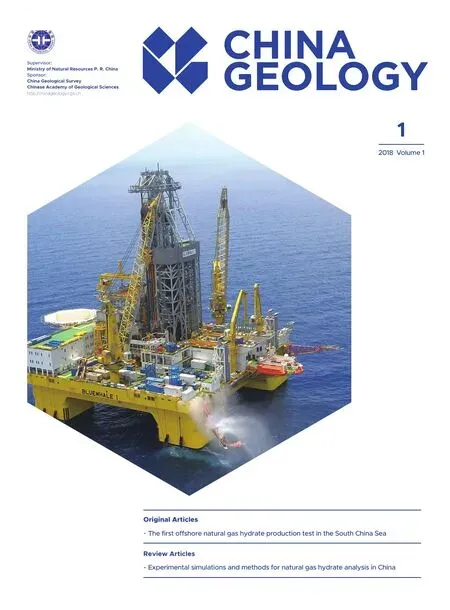The oldest shale gas reservoirs in southern margin of Huangling uplift, Yichang,Hubei, China
Xiao-hong Chen, Sheng-yuan Luo, An Liu, Hai Li
Wuhan Center of China Geological Survey, Wuhan 443003, China
1. Objective
Large-scale commercial production of shale gas started in Fuling, Changning and Weiyuan areas of the Sichuan Basin(Zou et al., 2016) since 2010. The most notable shale gas success is the Longmaxi organic rich Shale in Jiaoshiba field,Sichuan Basin. The Yichang slope is located in the north of middle Yangtze region. This eastward dipping slope is a new prospective area for shale gas exploration in recent 5 years.The gas-bearing shale system in the Yichang slope is underlain by the granite basement. The outcrop is exposed in the center of the Huangling Anticline. Early Paleozoic conventional natural gas was explored in Weiyuan and Gaoshiti in the north Sichuan Basin. The Precambrian Doushantuo shale in Yichang area is another prolific shale gas exploration target. The Doushantuo shale gas in Yichang slope is the earliest marine shale gas resource in the world, whose source rock was deposited between 635 and 551 Ma ago (Condon et al.,2005). Although the Yiye-1 well is finished recently, it is a significant innovation in shale gas exploration. The exploration of Doushantuo shale gas increases the unconventional hydrocarbon resources from Sichuan Basin to its adjacent areas(i.e. the Middle Yangtze Platform).
The marine-deposited Donshantuo shale contains large thickness, potentially favorable thermal maturity, and continuous features of seismic reflection co-axial. Lower Doushantuo units in the middle Yangtze area of China are the target strata for shale gas exploration. The lithology of Doushantuo unit is mainly comprised of microcrystalline limestone interbedded with black shale with abundant phosphatic nodules.Those strata were deeply buried in the early Mesozoic, and being uplifted during the late Mesozoic and Cenozoic.
The purpose of this project is to investigate the shale gas distribution and gas-bearing system of the Doushantuo Formation, and to identify the characteristics of shale gas capacities integrating with geological and geochemical data. This project provides the basic data for future exploration and development of the regional shale gas.
2. Methods
A geological investigation well (Well Yiye-1) was drilled by Wuhan Centre of China Geological Survey (CGS) in the southeast of Huangling Anticline in 2015-2016. Yiye-1well is located 25 km northwest to the Yichang city in Hubei province. The well was drilled from the Cretaceous Shimen Formation (Shimen F.M) to Neoproterozoic Formation with a total depth of 2418 meters in September 2016. Public drilling information on the shale formations in this area is quite limited. Data includes a 272 km 2-D seismic line, 4 geological survey wells, and limited geochemical test data (Fig. 1a). It helps identify the regional stratigraphy and structural characteristics, as well as the distribution and thickness variation.Standard core drilling, special logging and field analytical experiments are also carried out on the Yiye-1Well.
3. Results
The Doushantuo Formation is overlain by the Upper Sinian Dengying carbonate rock, and underline by the late Neoproterozoic glacial deposition, which is about 206 m thick in Yiye-1 well (Figure 1b). Shale member of Doushantuo Formation (Z1d2) is confined as the shelf deposits in sub-depressions of the continental margins corresponding to the lower part of a first marine transgression cycle, which aggregates 145 meter in thickness. Organic matter within Doushantuo shale is dominated by oil-prone typeⅠmarine kerogen that contains an average of 2.79 wt. % total organic carbon (TOC),with present-day thermal maturity between 2.06 and 2.66% equivalent vitrinite reflectance (Ro). The mineral composition of shale consists of 18.4% clay minerals, 25.2% quartz,4.5% calcite, 43.23% dolomite/ankerite, 2.28% pyrite, 6.4% feldspar and minor pyrite in some sample. Illite smectite mixed layer is the major clay mineral (Fig. 1c).

Fig. 1. (a) Geological map of the Yichang area, South China. (b) Geological section across study well. (c) Stratigraphic and lithological systems of the Precambrian Doushantuo shale References.
Measurement of total hydrocarbon and methane through mud logging indicates anomaly in depth from 2244 m to 2389 m.Total shale gas content is tested with core in the field analytical experiment. 47 measured samples within 145 m shows that the gas content of the Doushantuo shale in Yiye-1 well is ranging from 0.39 m3/t to 2.00 m3/t, averaging 1.08 m3/t. It reached the lower limit of commercial exploitation. In terms of its chemical composition, shale gas is typically a dry gas with more than 90% methane.
The reservoirs of Doushantuo shale are preserved in normal pressure, which differs from the large-scale commercial shale gas intervals of Fuling and Weiyuan areas of the Sichuan Basin. Large amount of geological information for natural gas were obtained from nearby geological investigation wells, which provided clear evidences for gas potential. Overall the Yichang area, with less complicated structural and faulting, is favorable for unconventional natural gas preserved.
4. Conclusion
The Precambrian Doushantuo shale in the Middle Yangtze is an important strata for shale gas exploration. Canister desor ption shale gas from 47 samples shows that total gas content typically ranged from 0.39 m3/t to 2.00 m3/t. The Doushantuo shale gas in Yichang slope area is the earliest marine shale gas resource in the world, which represents an enormous potential gas resource and a new prospective area for shale gas exploration outside the Sichuan hydrocarbon bearing basin.
- China Geology的其它文章
- A super-large graphite deposit discovered in granite rocks at Huangyangshan,Xinjiang, China
- Metamorphic petrology and geology in China: A review
- A discovery of Silurian tight shale gas in Jianshi, Hubei, China
- Three source rocks discovered in the Mid-Lower Jurassic, Dunhuang Basin in China
- Some progress on understanding the Phanerozoic granitoids in China
- New prospecting progress using information and big data of coal and oil exploration holes on sandstone-type uranium deposit in North China

